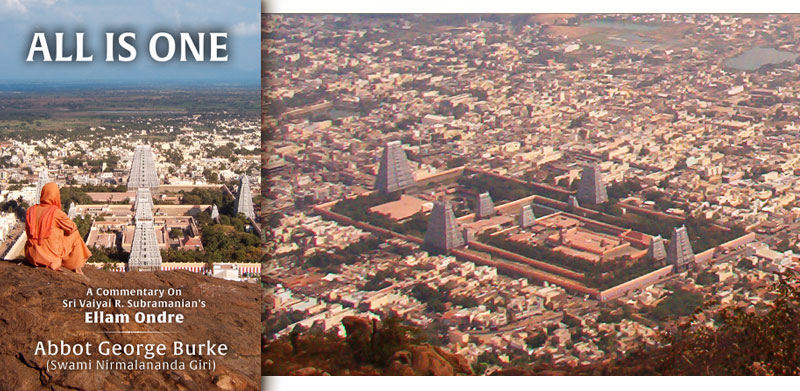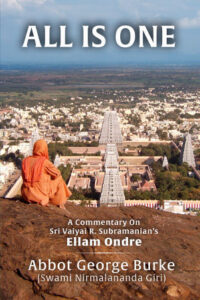
If you want moksha, read and practice the instructions in Ellam Ondre. (Ramana Maharshi)
“What is right?…It becomes necessary to realize that state which will enable us to assess the various conditions and determine what is right. That state is one only.”
Setting the tone in his preface, the Tamil author of the 19th century text Ellam Ondre establishes that his goal is to present practical Advaita; that is, to elucidate the steps on the path to Liberation, a state of consciousness that in turn affects all aspects of our life and our actions in this world.
Abbot George Burke’s insightful commentary brings even further light to Ellam Ondre’s refreshing perspective on what Unity signifies, and the path to its realization. Written in the colorful and well-informed style typical of his other commentaries, it is a timely and important contribution to Advaitic literature that explains Unity as the fruit of yoga sadhana, rather than mere wishful thinking or some vague intellectual gymnastic, as is so commonly taught by the modern “Advaita gurus.”
“Swami Nirmalananda’s commentary on this historic masterpiece gives the reader clarity and insight into what our true Self represents while navigating this world of Maya, this creation of Brahma. Through his knowledge of Advaita Vedanta and his down to earth explanations of the verses, one gets a clearer picture of why Sri Ramana Maharshi told his disciples to read this phenomenal book.”
–Stanley Wroblewski
-
Read the book online here
-
download a free PDF
-
study with your own paperback or ebook.
Excerpts from All Is One
7. Ask: “If in the world all things appear different, how can I consider all as one? Is there any way of gaining this knowledge?” The reply is: “In the same tree we see leaves, flowers, berries and branches, different from one another, yet they are all one because they are all included in the word ‘tree.’ Their root is the same; their sap is the same. Similarly, all things, all bodies, all organisms are from the same source and activated by a single life principle.” Therefore all is one. [Ellam Ondre]
This is the practical perspective we must have of ourselves and all humanity. Anyone can say, “It is all one,” but we must be those who live it.
This verse makes me think of my beloved Aunt Faye, who was father, mother and spiritual teacher to me from my age of six. During World War II she had gone to the south to be near my uncle George who was a patient in a military hospital. To manage this financially she got a job in Little Rock at Ottenheimer’s dress factory. Quite a few black people worked there at the lowest level jobs and wages, and Aunt Faye became friends with several of them. They used to come and tell her when they were being pushed around or mistreated by the supervisors, and she would go and complain and get them to stop. They also told her a lot of their griefs that took place outside the factory. She would tell me about them and literally cry bitter tears and say, “I am so worried about my friends because they don’t have anyone to speak up for them.”
Her bitterest memory was when one of the black workers came to her and asked to speak to her alone. He then asked her if she thought God had cursed the black people and made them that color. (This was and is common teaching in some churches. Supposedly the black people are descendants of Ham, the son of Noah whom Noah cursed and said his descendants would be slaves. See Genesis 9:22-27. One of my black friends from the island of Saint Thomas told me that she was taught this by black teachers when she went to school.)
“When he asked me that,” Aunt Faye told me, “I called inside to God to help me answer him.” And she began to point out to him that in all the things God created he made many differences, that every species of living being had many shapes and sizes and especially colors. And so it was with human beings that were all equal but different in appearance, and she quoted to him, “God that made the world and all things therein, hath made of one blood all nations of men for to dwell on all the face of the earth” (Acts 7:24, 26). Her friend smiled and said, “Yes, that’s right; that’s right!” and went away smiling. “But I,” Aunt Faye told me, “ran behind the bales of dress goods and cried and cried, just thinking of how terrible and cruel it was that anyone would tell my friends that God through Noah had cursed them and wanted them to be nothing but slaves and servants.” She had not read Ellam Ondre, but she had the same understanding.

However much I may speak of it, you cannot understand. It is a matter of experience. [Ellam Ondre]
This is certainly the truth; so why are there volumes and volumes of “Advaita” philosophy that claim to reveal the reality of our essential non-dual being to us by our mere reading of their words? When the future Swami Turiyananda met Sri Ramakrishna he told him that he studied Advaita texts for several hours a day. Ramakrishna was amazed and asked him why he needed to do such a thing since Shankara himself had written: “I shall tell you in half a sloka [verse] what has been written in tens of millions of books: Brahman is real. The world is illusory. The jiva is nothing other than Brahman.” This is why the Gita speaks of the “innermost secret: knowledge of God which is nearer than knowing, open vision direct and instant” (9:1), which can only be attained through yoga sadhana. We must KNOW the Self.

9. Unremittingly worship the God of your Self with the flower of your mind.
Worship, upasana, means “sitting near” or “drawing near.” This includes meditation, which is a process centered in the mind. We cannot sit in meditation all the day, so how can it be done unremittingly–all the time? By the simple practice of japa: repetition of a mantra. Sri M. P. Pandit wrote the following regarding the practice of japa.
“What is Japa? What is its rationale? What is its process? Japa is the repetition of a Mantra, a potent syllable or syllables, a word or a combination of words, done with the object of realizing the truth embodied in the Mantra [which] has the necessary power within it. And by constant repetition under proper conditions the power can be evoked into operation. The vibrations set up each time the Mantra is repeated go to create, in the subtler atmosphere, the conditions that induce the fulfillment of the object in view. The Divine Name, for instance, has the potency to stamp and mould the consciousness which repeats it into the nature of the Divinity for which the Name stands and prepare it for the reception of the gathering Revelation of the Godhead.
“At the basis of the Science of Japa is the ancient perception of sages all over the world that Creation proceeds from Sound. The universe has issued out of Nada Brahman, Brahman as Sound. This perception of the inherent power of sound, shabda, was applied with remarkable success by Indian adepts in Yoga who have reduced their knowledge and experience to an exact Science. When repeated for a long time, the Mantra goes on creating vibrations which press upon the layers of the inner consciousness till one day there comes a sudden opening and the Truth ensouled in the Mantra reveals itself.”
Read the first article in All Is One: Author’s Introduction to All Is One









